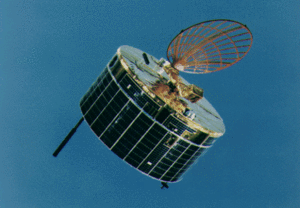
Back Сакигаке (космически апарат) Bulgarian Sakigake German Sakigake Spanish Sakigake French Sakigake Hungarian Sakigake ID Sakigake Italian さきがけ (探査機) Japanese 핼리혜성탐사시험기 사키가케 Korean Sakigake Latvian/Lettish
This article needs additional citations for verification. (April 2023) |
 Artist's rendering of the Sakigake spacecraft | |
| Mission type | Halley flyby |
|---|---|
| Operator | ISAS |
| COSPAR ID | 1985-001A |
| SATCAT no. | 15464 |
| Mission duration | 14 years and 1 day |
| Spacecraft properties | |
| Launch mass | 138.1 kilograms (304 lb)[1] |
| Start of mission | |
| Launch date | January 7, 1985, 19:27 UTC |
| Rocket | Mu-3SII |
| Launch site | Kagoshima |
| End of mission | |
| Last contact | Data: November 15, 1995 Beacon: January 8, 1999 |
| Orbital parameters | |
| Reference system | Heliocentric |
| Perihelion altitude | 0.92 AU |
| Aphelion altitude | 1.15 AU |
| Inclination | 0.07 degrees |
| Period | 382.8 days |
| Flyby of 1P/Halley | |
| Closest approach | March 11, 1986, 04:18 UTC |
| Distance | 6,990,000 kilometres (4,340,000 mi) |
Sakigake (さきがけ, lit. 'pioneer', 'pathfinder'), known before launch as MS-T5, was Japan's first interplanetary spacecraft, and the first deep space probe to be launched by any country other than the USA or the Soviet Union. It aimed to demonstrate the performance of the new launch vehicle, test its ability to escape from Earth gravity, and observe the interplanetary medium and magnetic field. Sakigake was also supposed to act as a frame of reference for data received from probes that flew closer to Halley's Comet. Early measurements would be used to improve the mission of the Suisei probe launched several months later.
Sakigake was developed by the Institute of Space and Astronautical Science for the National Space Development Agency (both of which are now part of the Japanese Aerospace Exploration Agency, or JAXA). It became a part of the Halley Armada together with Suisei, the Soviet Vega probes, the ESA Giotto and the NASA International Cometary Explorer, to explore Halley's Comet during its 1986 sojourn through the inner Solar System.
- ^ "Sakigake" (PDF). NASA. Retrieved December 2, 2022.